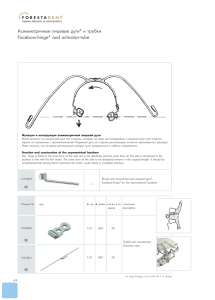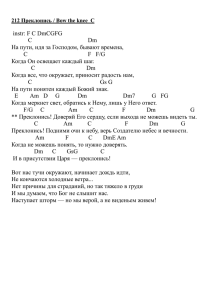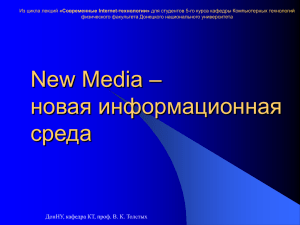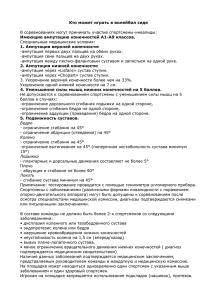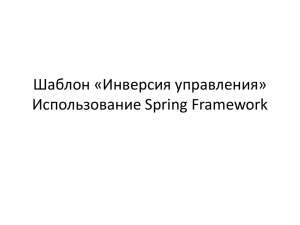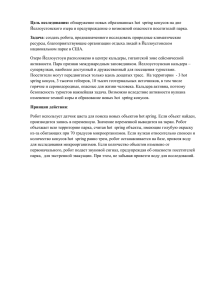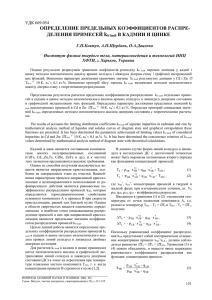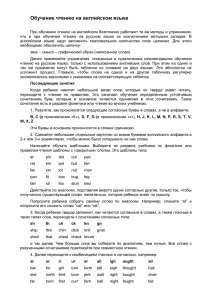Mathematical Model of bow
advertisement

Ksenia P. Frolova (student of SPbSTU, Department for Theoretical Mechanics) Оlga S. Loboda (PhD SPbSTU, Department for Theoretical Mechanics) Plan of the presentation Brief review Problem definition Results Experiment Conclusion 2 Principle of action Limbs bending 3 Classification of the bow Types of the bow 4 Compound bow Limbs bending 5 Problem definition Modeling: 1. Straight rigid beams jointed with a spiral spring 2. Thin flexible beams; deformations are small Function F(𝑥) dynamic curve Energy Initial velocity of arrow Compound bows: Comparison with classical bows 6 Model №1 Limbs are absolutely rigid rods Spiral spring placed between the rods Bow string is inextensible 1 – spring, 2 – limbs, 3 – bow string 7 Problem definition №1 M= 𝑐𝜑 Tℎ = M F = 2Tcos𝛽 𝑐𝜑 F=2 cos𝛽 ℎ M – spring moment с – spring stiffness 𝜑/2 – angle of limb deviation T – bow string tension force F – bow tension force 𝛽 – angle between the spring and the line of it’s removal 8 Function F(x) 𝐹 ′ (0) 𝐹 ′′ (0) 2 𝐹 ′′′ (0) 3 𝐹(𝑥)=F(0)+ 𝑥+ 𝑥 + 𝑥 +… 1! 2! 3! 2𝑐(𝑙 2 − 2𝑥02 ) 3 𝐹(𝑥)= 2 2 2 𝑥 2 𝑙 𝑥0 (𝑙 − 𝑥0 ) cubic dependence 9 Energy, Initial velocity of arrow Energy 𝑐 (𝑙 2 − 2𝑥02 ) 4 U= 𝑥 2𝑥02 𝑙 2 (𝑙 2 − 𝑥02 ) Initial velocity of arrow 𝑉0 = 2 𝑐(𝑙 2 − 2𝑥02 ) 𝑙𝑥0 𝑚(𝑙 2 − 𝑥02 ) 𝑥2 10 Model №2 Linear theory Static task Limbs - Bernoulli-Euler beams 11 Problem definition №2 𝐍′ = 0 M’ + 𝝉 × 𝐍= 0 ε = u’ + 𝝉 × 𝝍 = 0 𝟏 Ф=(с 𝒌𝒌 1 + 𝟏 𝒏𝒏 с2 + M = Mk Ф= 𝝍′ 𝟏 с3 𝝉 𝝉 )∙M N – force in cross-section of the limb M – moment in crosssection of the limb 𝝉 – vector of limb tangent ε – deformation shift vector u –removal vector 𝝍 – turn vector Ф – deformation vector с1, с2, с3 – stiffness tensor components 12 Solution boundary conditions: u|s=0 = 0 𝜓|s=0 = 0 N|s=l = N0 M|s=l = 0 u – movement vector 𝜓 - turn vector N – force in cross-section of the limb M – moment in crosssection of the limb s – coordinate along the limb l – length of the limb u|s=l = 𝑙3 N0 3𝑐1 u – movement vector N0 – force in cross-section of the limb 13 Decision 𝑥 F = 𝑝2 − (𝑙𝑠𝑖𝑛𝛼 − 𝑙3 F𝑐𝑡𝑔𝛼)2 6с1 + 𝑙𝑐𝑜𝑠𝛼+ 𝑙3 6с1 F − 𝑥0 3с1 𝑠𝑖𝑛𝛼( 𝑥 + 𝑥0 𝑠𝑖𝑛𝛼 + 𝑝2 − (𝑙 − 𝑥 + 𝑥0 𝑐𝑜𝑠𝛼)2 ) 𝑉0 = 2 𝑥 3 𝑚𝑙 14 Modeling of compound bow BC F T AB F – cable tension force , T – string tension force 15 Experiment №1 b o w Fixing of the handle loads Measurement of spring removal 16 Experiment №2 compound bow «Ястреб» block 17 List of parameters №1 Parameter Designation Value Length of the limb l 0.650 m Considering length of the string p 0.625 m Initial removal x0 0.180 m Young modulus E 21 GPa Cross-section height h 0.009 m Cross-section width b = b(z), z=[0..l], (м) b = 0.0316z+0.01, m Fmax 11.5 kgf Maximum effort 18 List of parameters №2 Parameter Designation Parameter Designation Length of the limb 0.410 m Radius of the big block 0.027 м Length of the string 1. 032 m Radius of the small block 0.020 м Length of the cable 1.040 m Initial removal 0.190 м 20 kgf Height width of cross-section 0.008 м 0.05 0.08 м Maximum effort 19 Bow stiffness in model №1 The Method of Least Squares 𝑁 S= Fэксп 𝑖=1 𝑙2 2 2𝑐 − 2𝑥0 3 𝑥𝑖 − 2 2 2 𝑥 𝑙 𝑥0 𝑙 − 𝑥02 𝑖 2 𝜕𝑆 =0 𝜕𝑐 𝑐 = 23.169 N ∙ m 20 Bow stiffness in model №2 с = 𝐸𝐼 bℎ3 I= 12 𝑏 = 0.0316𝑧 + 0.01 𝑐 = 24.852 Н ∙ м2 E – Young modulus, I – moment of inertia of cross-section of the limb 21 Dynamic curve 22 Bow energy 23 Initial velocity of arrow 24 Dependence of effort from removal 25 Conclusion 1. Mathematical description of bow with straight rigid limbs jointed with a spiral spring 2. Mathematical description of bow with thin flexible limbs Bows with flexible beams more powerful then bows with straight rigid beams Model of bow with flexible beams describe the real construction more correctly. It is also more effective. System of blocks can be used in more powerful bows 26 REFERENCES 1. 2. 3. 4. 5. 6. 7. 8. 9. 10. 11. 12. 13. 14. Б.А. Виноградский. Анализ состояния и перспективы развития стрельбы из лука в мире с учетом результатов 28 Олимпийских игр в Афинах // Наука в олимпийском спорте – 2005 - № 2 - с. 60 – 68. I.F. Zaniewski. Modeling of the archery bow and arrow vibrations // Shock and Vibration – 2009 - №3 - p. 307 – 317. С. Кондратьев. Термины в стрельбе из лука [электронный ресурс] // Стрельба из лука: [сайт ] – 2011 – URL: http://www.archerysila.ru/ Э. Макьюэн, А. Миллер, А. Бергман. Конструкция и изготовление древних луков. // В мире науки – 1991 - № 8 - с. 38–75. В.Н. Казанцев. Пособие для начинающих лучников [электронный ресурс] // Стрельба из лука: [сайт ] – 2009 – URL: http://www.archery-sila.ru/ И.Ф. Заневский. Компьютерная модель внутренней баллистики стрелы лука // Сборник научных трудов "Вестник НТУ "ХПИ": Информатика и моделирование – 2011 - №36 - c. 78 – 86. C.N. Hickman. Dynamics of a bow and arrow // Journal of Applied Physics – 1937 - V. 8 - p. 404-409. B.W. Kooi, J.A. Sparenberg. On the static deformation of a bow // Journal of Engineering Mathematics – 1980 - V. 14, № 1 - p. 27-45. А.А. Лужин. Моделирование выстрела из лука: дис. на соискание ученой степени канд. физ.-мат. Наук – Москва, 2008 - 103 с. T.M. Hamilton. Native American Bow. Columbia: Published by Missouri Archeological Society, 1982 – 148 p. B.W. Kooi. Archery and mathematical modeling // Journal of The Society of Archer-Antiquaries – 1991 - V.34,.p. 21 – 29. J.L. Park. The behaviour of an arrow shot from a compound archery bow // Proc. Of the IMechE, Part P: Journal of Sports Engineering and Technology. – 2011. – V. 225, № 8. – p. 8 - 21. П.А. Жилин. Прикладная механика. Теория тонких упругих стержней. СПб.: Изд-во Политехнического университета, 2007 - 101 с. J.E. Gordon. Structures, or why Things don't Fall Down. Harmondsworth: Published by the Penguin Books, 1978 – 395 p. 27
